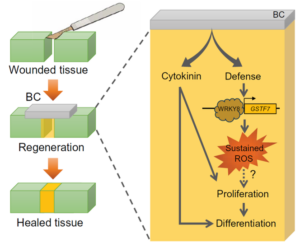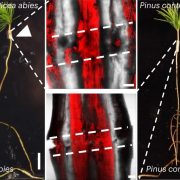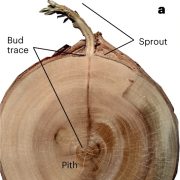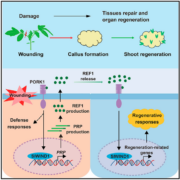Healing Plants: how bacterial cellulose boosts plant regeneration
 Have you ever placed a leaf from a Monstera plant in a glass of water and watched it grow new roots, forming a new plant? This happens because plants have a much greater ability to regenerate their tissues compared to animals. Recently, in Ruiz-Solaní et al., Spanish researchers have found a way to improve this regeneration, applying bacterial cellulose (BC) to plant wounds. BC is a biopolymer produced by specific bacterial strains that has been widely utilized in human biomedical applications as a scaffold for tissue regeneration. They found that applying bacterial cellulose to artificially cut leaves improved tissue regeneration—in other words, the cuts healed. Additionally, the compound contains plant hormones, such as cytokinin and auxins, which promote cell proliferation and differentiation. Additionally, BC activates plant defense mechanisms against microbial threats, particularly by inducing a reactive oxygen species (ROS) burst, a key response that further supports tissue regeneration. These findings not only shed light on alternative regenerative processes in plants but also open new possibilities for biotechnological applications aimed at improving plant resilience and recovery after injury. (Summary by Carlos González Sanz @carlosgonzsanz.bsky.social) Sci. Advances 10.1126/sciadv.adr1509
Have you ever placed a leaf from a Monstera plant in a glass of water and watched it grow new roots, forming a new plant? This happens because plants have a much greater ability to regenerate their tissues compared to animals. Recently, in Ruiz-Solaní et al., Spanish researchers have found a way to improve this regeneration, applying bacterial cellulose (BC) to plant wounds. BC is a biopolymer produced by specific bacterial strains that has been widely utilized in human biomedical applications as a scaffold for tissue regeneration. They found that applying bacterial cellulose to artificially cut leaves improved tissue regeneration—in other words, the cuts healed. Additionally, the compound contains plant hormones, such as cytokinin and auxins, which promote cell proliferation and differentiation. Additionally, BC activates plant defense mechanisms against microbial threats, particularly by inducing a reactive oxygen species (ROS) burst, a key response that further supports tissue regeneration. These findings not only shed light on alternative regenerative processes in plants but also open new possibilities for biotechnological applications aimed at improving plant resilience and recovery after injury. (Summary by Carlos González Sanz @carlosgonzsanz.bsky.social) Sci. Advances 10.1126/sciadv.adr1509






